A Simple Guide to All Sony Alpha 7 Lenses: Which E-Mount Full-Frame FE Lens Is the Best for You?
Latest update: November 14, 2022
We’re proud owners of a Sony Alpha 7II and we would never want to part without this great camera. In this guide we’ll show you which lenses are available for the Alpha 7 series. If you’re looking for the perfect full-frame lens for E-mount cameras, you’ve come to the right place!
Sony’s full-frame mirrorless cameras have been around for quite some time now, and there are a vast array of lenses available for the cameras these days.
To give you an up-to-date overview, we’ll give you a rundown of the most interesting lenses currently available for the Sony Alpha 7 cameras in this post.
We’ve provided a link to the product page on Amazon for each featured lens, so you can check the current prices and look for deals from Amazon Marketplace sellers.
Buying Sony Alpha 7 lenses: What to look out for
Reading through some of the questions from our readers, we’ve noticed that there’s quite a bit of confusion when it comes to Sony lenses. So we thought it would be helpful to start with a general introduction.
A-mount vs. E-mount: What’s the difference?
Sony lenses come with two different mounts: A-mount and E-mount.
E-mount lenses are designed for Sony’s range of mirrorless system cameras (Alpha 7 series, Alpha 6000 and 5000 series, and NEX series).
A-mount lenses only work on Sony’s range of DSLRs.
So not every Sony lens fits on every Sony camera. That’s why you should always make sure to buy an E-mount lens if you own a mirrorless system camera from Sony.
Most online stores, including Amazon, feature the mount and compatible camera systems in the product title on their websites. If you’re still unsure if the lens is compatible, just browse the product description or use Amazon’s handy “Confirmed Fit” checker.
Here’s an easy way to tell them apart: Model numbers for E-mount lenses start with “SEL”, while numbers for A-mount lenses start with “SAL”.
Full format vs. APS-C: What’s the difference?
There are also differences within the E-mount lens range. While the Alpha 7 series cameras come with a full-format sensor installed, the Alpha 6000 series, for example, uses an APS-C sensor.
This affects how the lenses perform on the different camera types. So always make sure it says something like “suitable for full frame” when you’re shopping for Alpha 7 lenses.
Or you can just carry on reading this guide because all the lenses we’ll be presenting here are suitable for full frame and are fully compatible with the following cameras:
- Sony Alpha 1
- Sony Alpha 7
- Sony Alpha 7 II
- Sony Alpha 7 III
- Sony Alpha 7R
- Sony Alpha 7R II
- Sony Alpha 7R III
- Sony Alpha 7R IV
- Sony Alpha 7S
- Sony Alpha 7S II
- Sony Alpha 7S III
- Sony Alpha 7C
- Sony Alpha 9
- Sony Alpha 9 II
Also check out our detailed camera buying guide
Can I use a Sony Alpha 6000 lens on a Sony Alpha 7 camera?
As we mentioned above, there are E-mount lenses made specifically for full-frame cameras such as the Sony Alpha 7 II and lenses for APS-C cameras such as the Sony Alpha 6000.
They use the same mount, so that you can use all lenses listed here on both systems. Just be aware that the focal length will vary from system to system because of the so-called crop factor.
In a nutshell: As a rule, you can can use all E-mount lenses on both systems. We still recommend that you use the lenses designed specifically for your camera format.
If you want to learn more about APS-C sensor lenses for Sony cameras, we’ve also compiled also a detailed overview of the most important lenses available in that format:
Sony Alpha 7 lenses by third-party manufacturers
Most lenses for the Sony Alpha 7 series are produced by Sony itself, as well as by Zeiss.
Some of the Zeiss lenses are marketed under the Sony brand, others directly under the Zeiss brand.
But nowadays, you can also choose from a number of lenses for the Alpha 7 series produced by third-party manufacturers such as Tamron and Sigma.
There are quite a few third-party manufacturers in the prime lens segment, ranging from relatively low-cost lenses by Samyang to highly specialized lenses by high-end manufacturers such as Meyer Optik Görlitz and Voigtländer.
We have nothing bad to say about third-party lenses in general. We actually use Tamron lenses ourselves and are very happy with them. So you might also want to consider going third party to take advantage of a wider range of options or better value for money.
E-mount full-frame zoom lenses for the Sony Alpha 7 series
Let’s kick things off with the typical zoom lenses for the Sony Alpha 7 series. There’s a considerable range of options in this category, so we’re going to start with our two absolute favorites.
Amazing value for money: Tamron 28-75 mm, f/2.8
Our tip for price-conscious photographers!
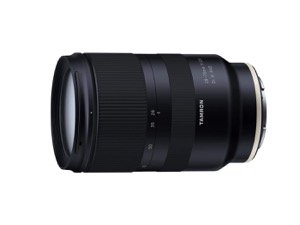 After a long period of hesitation,Tamron finally released a lens for full-frame E-mount cameras. And it packs quite a punch!
After a long period of hesitation,Tamron finally released a lens for full-frame E-mount cameras. And it packs quite a punch!
With 28 to 75 mm, the lens covers the most important focal lengths for everyday use and of course a fixed aperture of f/2.8 is really great too.
Another major advantage is its low weight of only 550 grams.
But the absolute best thing about it is its low price: You can get the Tamron 28-75 for less than 700 euros!
The premium zoom lens: Sony 24-70 mm, f/2.8
Our tip for maximum quality!
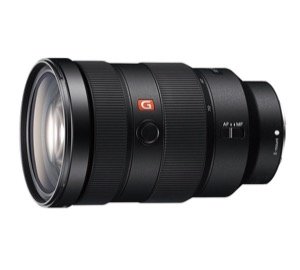 The best, but also most expensive choice among the zoom lenses for the Alpha 7 series is the 24-70 mm G Master lens with an aperture of f/2.8.
The best, but also most expensive choice among the zoom lenses for the Alpha 7 series is the 24-70 mm G Master lens with an aperture of f/2.8.
Sony’s G Master lenses promise a particularly high level of detail and outstanding bokeh. After weighing the pros and cons, we went ahead and bought this lens and are absolutely thrilled with it.
The picture quality really raises the bar and the fixed aperture of f/2.8 makes this lens a reliable companion even in bad lighting conditions.
Even though the lens is far from a bargain at around 1,800 euros, we’d buy it again in a heartbeat.
The simple kit lens: Sony 28-70 mm, f/3.5-5.6
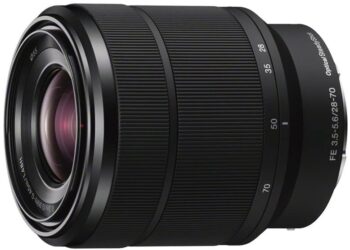 Kit deals are also available for professional cameras. Who would have thought? Since it was barely more expensive than just buying the body, we also bought our cameras in a kit with the 28-70 mm, f/3.5-5.6 zoom lens included.
Kit deals are also available for professional cameras. Who would have thought? Since it was barely more expensive than just buying the body, we also bought our cameras in a kit with the 28-70 mm, f/3.5-5.6 zoom lens included.
We can already hear some of you protesting, “Why would you put a kit lens on such an expensive camera?!”
But this time, the outcry is unwarranted – this lens offers a more than decent image quality and we recommend it wholeheartedly.
For example, we took all the photos on our trip to Myanmar with this lens. So go ahead and check those out and judge the image quality for yourself!
If you haven’t bought a Sony Alpha 7 III yet, we recommend purchasing the camera in a kit. That way, you’ll spend a bit less on the lens than if bought separately. Sold individually, it’s currently available for about 300 to 400 euros.
To the kit on Amazon
To the individual lens on Amazon
The very compact kit lens: Sony 28-60 mm, f/4-5.6
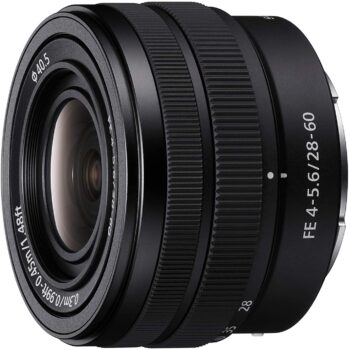 This lens is also available in a kit with the Sony Alpha 7C, a very compact full-frame camera from Sony. And so of course the lens is compact as well.
This lens is also available in a kit with the Sony Alpha 7C, a very compact full-frame camera from Sony. And so of course the lens is compact as well.
It actually only weighs about 167 grams, fits in the smallest pocket, and doesn’t put so much strain on your shoulders.
Of course with a lens that compact, there are some trade-offs in performance. For example, the lens only has an initial aperture of f/4-5.6. It isn’t protected against dust and splash water, and there are certainly better lenses in terms of image quality.
Nevertheless, the lens is an affordable starting point for getting into photography, especially when purchased in a kit. And its compact size really comes in handy when you’re traveling. The lens currently costs 380 euros on its own. That’s an okay price, but you can save even more money buying it in a kit.
The better kit lens: Sony / Zeiss 24-70 mm, f/4
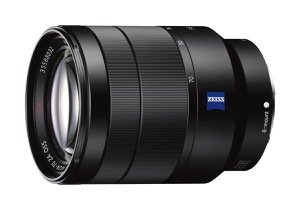 The Sony SEL2470Z offers even higher quality than the 28-70. It has a good resolution in all zoom ranges, a fixed aperture of f/4, and a slightly wider angle of view than the 28-70 mm.
The Sony SEL2470Z offers even higher quality than the 28-70. It has a good resolution in all zoom ranges, a fixed aperture of f/4, and a slightly wider angle of view than the 28-70 mm.
An all-around satisfying and high-quality lens with Zeiss technology for everyday use.
Of course quality has its price: Sony’s recommended retail price is 1,249.00 euros, but you should able to pick one up for around 700 euros.
Kit offers for this lens are particularly attractive. The Sony Alpha 7 II with the 24-70 mm lens is available for about 1,700 euros.
Cheaper premium alternative: Sigma Art 24-70 mm, f/2.8
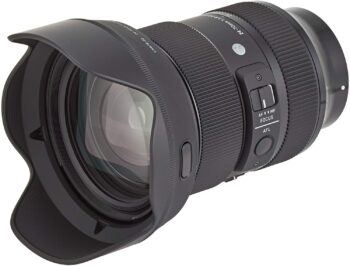 The Sigma 24 to 70 mm is part of Sigma’s Art series. These lenses were developed specifically for high demands on image quality.
The Sigma 24 to 70 mm is part of Sigma’s Art series. These lenses were developed specifically for high demands on image quality.
And this lens certainly lives up to those demands. It can easily go toe to toe with the Sony 24 to 70 mm. Top image quality, fast, quiet, and slightly more compact and lighter than the Sony G Master.
And the best part: The lens costs about 600 euros less than its Sony counterpart at 1,200 euros.
A bigger zoom lens: Sony 24-105 mm, f/4
The 24-105 mm lens is the latest zoom lens released by Sony.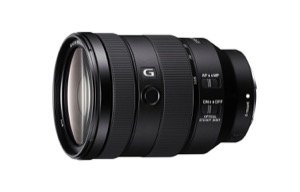
Its zoom range of 24 to 105 mm offers the perfect focal length for a wide variety of situations. One great advantage is its relatively low weight of 663 grams, which is significantly lighter than other Sony zoom lenses.
These specs make this lens is a worthy competitor to the Tamron lens profiled above. While its wider focal length range focal is certainly very impressive, it has a considerably smaller aperture.
This lens is priced at around 1,300 euros.
For recording video: Sony 28-135 mm, f/4
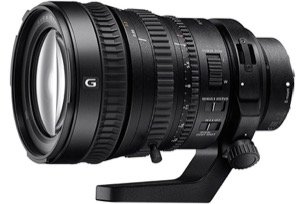 This lens was designed specifically for the requirements of recording video.
This lens was designed specifically for the requirements of recording video.
The dedicated Smooth Motion Optics design provides the best possible image quality for filming and the precise and quiet autofocus is perfectly suited for the requirements of filming.
With a weight of 1.2 kg and a price of about 2,000 euros, this lens is primarily intended for use as a specialized tool for professional video recording.
The travel zoom lens: Sony 24-240 mm, f/3.5-6.3
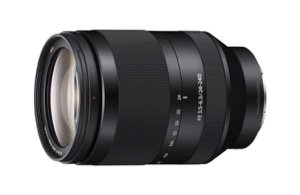 The SEL24240 is an all-rounder for on the road. It has the largest zoom range of all full-frame E-mount lenses.
The SEL24240 is an all-rounder for on the road. It has the largest zoom range of all full-frame E-mount lenses.
The SEL24240 is protected against dust and moisture and is a good always-on lens for your travels, whether you’re shooting snapshots, landscapes, or wildlife photos. The only drawback is the weight of 780 grams, but that’s still low compared to most telephoto lenses.
While it can’t rival a specialized lens in terms of quality, it’s still a great choice for traveling. It’s currently priced at around 800 euros.
Travel zoom alternative: Tamron 28-200 mm, f/2.8-5.6
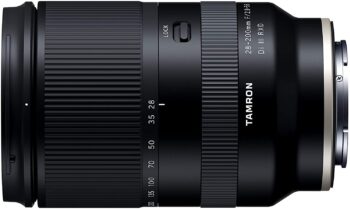 Tamron also has an all-rounder of their own in their product range. There are hardly any differences to the Sony.
Tamron also has an all-rounder of their own in their product range. There are hardly any differences to the Sony.
The most noticeable difference is that the Sony has a slightly wider focal length range of 24-240 mm. The Tamron has a range of 28-200 mm. But that doesn’t make much of a difference in practice.
The closest focusing distance, i.e. the minimum distance you have to keep to your subject to get it in focus, is significantly lower with the Tamron. That’s 19 cm compared to 50 cm with the Sony. While that’s still far from macro, you can definitely get much closer to small flowers or similar subjects.
The lens is very similar to the Sony, so it’s more a matter of taste which lens you prefer. Like the Sony, the Tamron is also priced at around 800 euros.
Wide angle lenses for the Alpha 7 series
When it comes to wide angle zoom lenses, the selection is fairly limited. Sony has a total of three lenses on offer, which are very good but unfortunately also very pricey. Then there’s also one from Tamron and another from Sigma.
Zeiss 16-35 mm, f/4
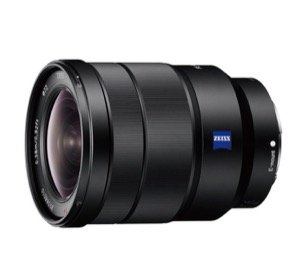 This is one of very few wide-angle zoom lenses available for the Alpha 7 series, but it leaves nothing to be desired. We own this lens ourselves and are very satisfied with it.
This is one of very few wide-angle zoom lenses available for the Alpha 7 series, but it leaves nothing to be desired. We own this lens ourselves and are very satisfied with it.
The maximum aperture is f/4, which is perfectly fine for a wide angle. The zoom range of 16-35 mm gives you a lot of flexibility for different situations, so you can leave this lens on the camera a lot of the time.
This lens is currently priced at around 1,100 euros.
Sony 16-35 mm, f/2.8
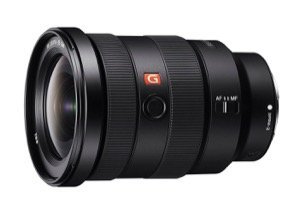 A brand new G Master version of the 16-35 mm has just been released. With an aperture of f/2.8 and the image quality the G Master lenses are famous for, this lens is the absolute cream of the crop when it comes to wide-angle lenses for the Sony Alpha 7 series.
A brand new G Master version of the 16-35 mm has just been released. With an aperture of f/2.8 and the image quality the G Master lenses are famous for, this lens is the absolute cream of the crop when it comes to wide-angle lenses for the Sony Alpha 7 series.
Of course all this has its price, and it’s quite steep at about 2,300 euros.
Price recommendation: Tamron 17-28 mm, f/2.8
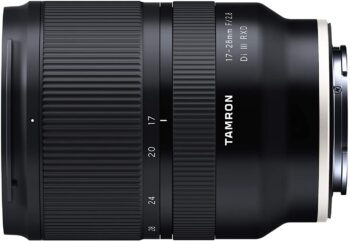 This lens isn’t just cheap in comparison, but cheap in general for a lens with these specs. It only costs 850 euros! That’s considerably cheaper than any of the other wide-angle lenses featured here.
This lens isn’t just cheap in comparison, but cheap in general for a lens with these specs. It only costs 850 euros! That’s considerably cheaper than any of the other wide-angle lenses featured here.
It has a very compact build, is sealed against dust and splash water, and even comes with a filter thread. What’s more, it has a practical zoom range of 17-28 mm and a very good lens speed of f/2.8.
Of course, the picture quality is also perfectly fine. A clear recommendation at that price!
Sony 12-24 mm, f/4
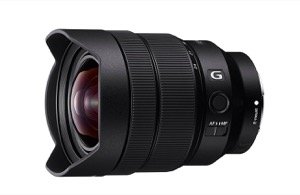 For a long time there were hardly any alternatives for full-format cameras with an E-mount in the field of wide-angle lenses, but now Sony has finally added one to its range.
For a long time there were hardly any alternatives for full-format cameras with an E-mount in the field of wide-angle lenses, but now Sony has finally added one to its range.
This 12-24 mm lens is an ultra wide-angle lens that meets the highest demands. The price for this lens is about 1,600 euros, so it’s not exactly a bargain.
Sigma 14-24 mm, f/2.8
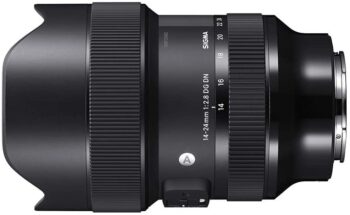 In terms of focal length range, this lens is a direct competitor to the Sony 12-24 mm f/4. However, the Sigma is significantly faster with an aperture of f/2.8 and still only slightly heavier at around 795 grams.
In terms of focal length range, this lens is a direct competitor to the Sony 12-24 mm f/4. However, the Sigma is significantly faster with an aperture of f/2.8 and still only slightly heavier at around 795 grams.
Quality-wise, it’s a great lens. We definitely recommend it over the Sony 12-24 and if you can live without 35 mm, also over the Zeiss 16-35 or the Sony G Master. And last but not least, the lens is also comparatively affordable at around 1,450 euros.
Telephoto lenses for the Alpha 7 series
There are a total of three telephoto lenses for the E-mount full frame, which all have a relatively similar aperture range.
The lightest zoom lens: Sony 70-300 mm, f/4.5-5.6
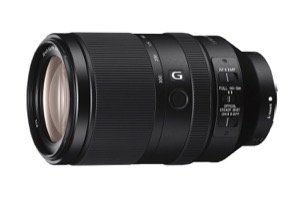 This lens offers a larger zoom range with a focal length of 70-300 mm. The downside is the underwhelming aperture between f/4.5 and 5.6.
This lens offers a larger zoom range with a focal length of 70-300 mm. The downside is the underwhelming aperture between f/4.5 and 5.6.
On the other hand, with a weight of 850 grams, this lens is pretty light. It’s priced at around 1,100 euros.
Best focal length: Sony 200-600 mm, f/5.6-6.3
The Sony SEL200600G boasts the widest focal length range of any Alpha 7 telephoto lens by a long shot.
No other lens on the market comes close to its maximum focal length of 600 mm. If that sounds appealing to you, you’ll have to invest around 1,700 euros.
Fast telephoto zoom: Tamron 70-180 mm, f/2.8
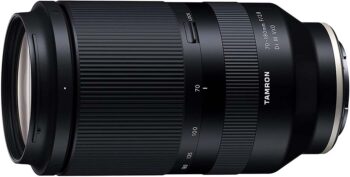 The Tamron 70 to 180 mm is a real insider tip. The lens has a speed of f/2.8 in combination with a focal length of 70 to 180 mm. It’s very compact for this type of lens and only weighs 815 grams.
The Tamron 70 to 180 mm is a real insider tip. The lens has a speed of f/2.8 in combination with a focal length of 70 to 180 mm. It’s very compact for this type of lens and only weighs 815 grams.
The image quality is very good, and thanks to the open aperture, the lens is ideal for portraits as well as sports photography.
One drawback is that this lens doesn’t have an integrated image stabilizer. However, almost all mirrorless full-frame cameras from Sony now come with an integrated stabilizer of their own, so there’s no need for one in the lens.
Nevertheless, this lens gets clear a recommendation from us, and it’s also reasonably priced at around 1,100 euros.
Macro lenses for the mirrorless full-frame cameras from Sony
Nowadays, there are several macro lenses available for Sony’s full-frame mirrorless cameras. Here are our favorites:
Sony 50 mm, f/2.8
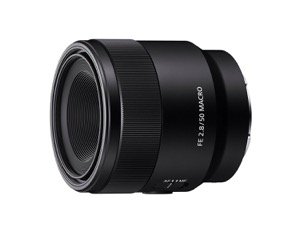 It starts with the 50 mm from Sony. This lens is a macro lens and it does its job very well.
It starts with the 50 mm from Sony. This lens is a macro lens and it does its job very well.
If you’re interested in macro photography and are looking for the right lens for the Alpha 7 series, this is a very good choice. The price is also pretty reasonable at just under 470 euros.
Sigma Art 70 mm, f/2.8
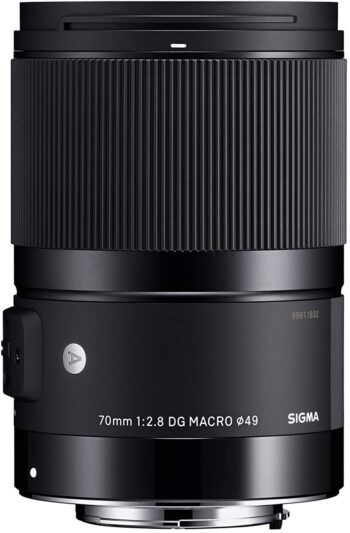 The macro lens from Sigma with a focal length of 70 mm belongs to Sigma’s Art series, which stands for the highest optical performance.
The macro lens from Sigma with a focal length of 70 mm belongs to Sigma’s Art series, which stands for the highest optical performance.
The lens is very sharp, but the autofocus could be a bit faster. Still, you get a very good lens for your money. It currently costs about 500 euros.
Sony 90 mm, f/2.8
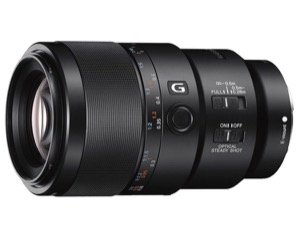 At the higher end of the focal length scale below the prime lenses with autofocus is Sony’s 90 mm lens, which was specially designed to meet the requirements of macro photography.
At the higher end of the focal length scale below the prime lenses with autofocus is Sony’s 90 mm lens, which was specially designed to meet the requirements of macro photography.
The lens is pretty bulky and definitely not a lightweight, but it does an excellent job at macro photography. It’s priced at just under 1,000 euros.
Sigma Art 105 mm, f/2.8
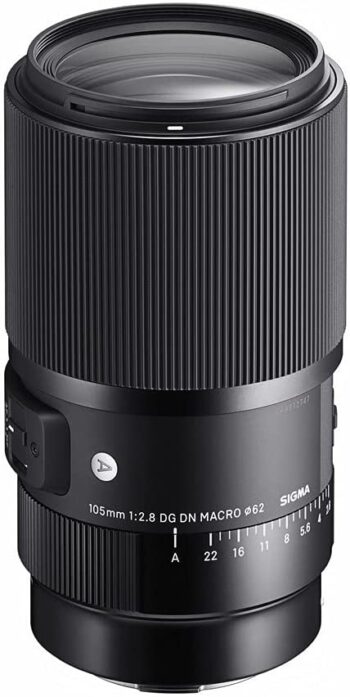 This lens is a very good and slightly cheaper alternative to the 90 mm macro lens from Sony.
This lens is a very good and slightly cheaper alternative to the 90 mm macro lens from Sony.
It belongs to Sigma’s Art series and thus has a very high-quality build and provides excellent image quality.
What’s more, there are several switches on the lens to manually adjust the aperture, change the autofocus mode, and even a button that you can program yourself.
For the performance and the low price of about 750 euros, this lens is our recommendation for macro photography.
E-mount full-frame prime lenses for the Sony Alpha 7 series
There’s a much wider range of prime lenses with a fixed focal length available for the Sony Alpha 7 series.
Not only Zeiss and Sony, but also numerous third-party manufacturers have staked their claim in this segment.
There are more than 50 prime lenses for E-mount full frame.
To keep this post from going on forever, we’ll only be profiling lenses that use autofocus.
We’ve listed the lenses without autofocus below, but without a full profile. Let’s get started.
Prime lenses for the Sony Alpha 7 series WITH autofocus
The following section features the prime lenses available for full-frame E-mount. We’ve sorted the lenses in ascending order by focal length.
Samyang 14 mm, f/2.8
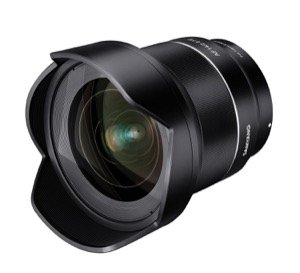 This 14 mm wide angle lens is one of only two lenses with autofocus for the Alpha 7 series made by Samyang.
This 14 mm wide angle lens is one of only two lenses with autofocus for the Alpha 7 series made by Samyang.
The lens offers good image quality, is fast, and at a price of less than 600 euros, it’s also pretty good value for money.
Biggest drawback: The lens hood is fixed so you can’t attach any screw-on filters.
Sony 14 mm, f/1.8
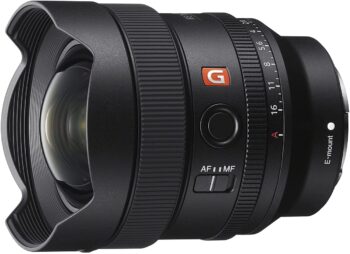 The Sony 14 mm is the perfect lens for taking photos of the starry sky at night. But of course, the lens is also superb during the day.
The Sony 14 mm is the perfect lens for taking photos of the starry sky at night. But of course, the lens is also superb during the day.
With its focal length of 14 mm, the lens falls into the wide-angle category. It offers incredible image quality, but at a very high price. You should expect to pay about 1,500 euros.
Zeiss Batis 18 mm, f/2.8
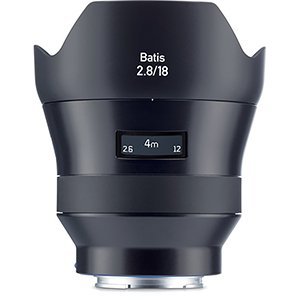 Zeiss delivers a high-quality wide-angle prime lens with its 18 mm lens from the Batis series.
Zeiss delivers a high-quality wide-angle prime lens with its 18 mm lens from the Batis series.
The lens is ideal for landscape photography. The image quality is outstanding, even with an open aperture. The lens is also protected against dust and splash water.
It’s also relatively expensive at just under 1,200 euros.
Sigma Art 20 mm, f/1,4
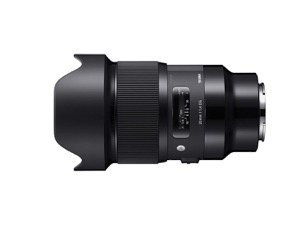 After a long absense from the E-mount full-frame camera market, Sigma has finally introduced several prime lenses from its popular Art series.
After a long absense from the E-mount full-frame camera market, Sigma has finally introduced several prime lenses from its popular Art series.
One of them is the 20 mm with an aperture of f/1.4. The lens is perfect for landscape and architecture photographs. It costs about 800 euros.
Sony 20 mm, f/1.8
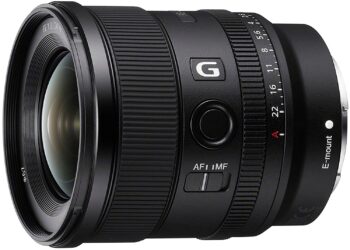 Another wide-angle lens from Sony. This one has very high-quality build, the product of excellent optical and technical workmanship. And the image quality is impeccable.
Another wide-angle lens from Sony. This one has very high-quality build, the product of excellent optical and technical workmanship. And the image quality is impeccable.
Whatvs great about this lens is its very compact design despite the large aperture. It only weighs about 373 grams, making it an excellent choice for travel photography.
The lens costs about 900 euros.
Tamron 20mm, f/2,8
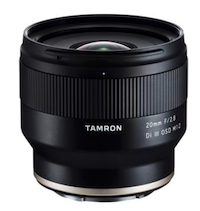 Tamron released two very promising new prime lenses in November 2019.
Tamron released two very promising new prime lenses in November 2019.
The 20 mm offers the widest angle of view, while also allowing you to shoot photos from a close-up distance of 11 cm. This is the first lens in this category that can take macro shots at a scale of 1:2.
The lens only weighs 220 grams and costs around 325 euros.
Tamron 24mm, f/2.8
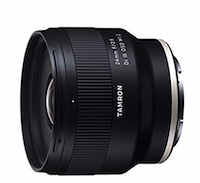 The 24 mm wide-angle also allows for a tiny closest focusing distance of 12 cm. That means you can use the lens for both landscape and close-up photography.
The 24 mm wide-angle also allows for a tiny closest focusing distance of 12 cm. That means you can use the lens for both landscape and close-up photography.
And weighing in at around 200 grams, it’s also relatively light, making it a superb travel accessory.
The Tamron 24 mm is available starting at around 400 euros.
Sigma Art 24 mm, f/1.4
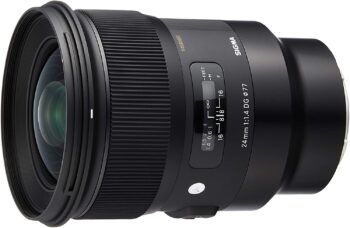 The Sigma Art 24 mm is also a very fast lens and great for night shots. The only difference to the 20 mm is the narrower angle of view.
The Sigma Art 24 mm is also a very fast lens and great for night shots. The only difference to the 20 mm is the narrower angle of view.
That could make it more challenging if you want to include some of the landscape in your pictures of the night sky, for example. But it’s lighter than the 20 mm and also a little bit cheaper at about 700 euros.
Sony 24 mm, f/1.4
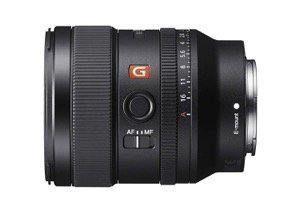 The G Master series are the premium lenses by Sony. They are incredibly good, but also incredibly expensive.
The G Master series are the premium lenses by Sony. They are incredibly good, but also incredibly expensive.
For example, you can expect to pay almost 1,400 euros for the 24 mm prime lens. But for that money you get an excellent lens that works perfectly even in low light conditions.
Zeiss Batis 25 mm, f/2
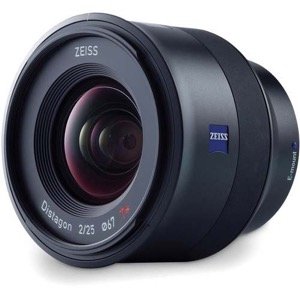 The Zeiss 25-series is already considered a classic among the wide-angle prime lenses for the Sony Alpha 7 series. It’s frequently cited as the best wide-angle lens for E-mount cameras.
The Zeiss 25-series is already considered a classic among the wide-angle prime lenses for the Sony Alpha 7 series. It’s frequently cited as the best wide-angle lens for E-mount cameras.
The lens is very fast with an aperture of f/2. It’ll take up a fair bit of space in your camera backpack, but at least it’s relatively light.
It’s priced at around 1,000 euros, but the lens is definitely worth it.
Sony 28 mm, f/2
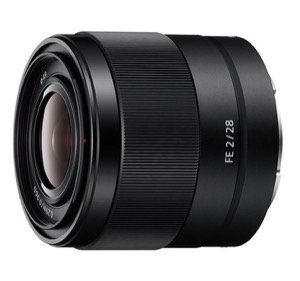 This lens is a great place to dip your toes into the world of prime lenses if you don’t want to go all-in right away. With its f/2 aperture, it’s very fast and takes good pictures even in low light conditions.
This lens is a great place to dip your toes into the world of prime lenses if you don’t want to go all-in right away. With its f/2 aperture, it’s very fast and takes good pictures even in low light conditions.
The autofocus works reliably and at a price of around 400 euros you can’t really go wrong with this lens.
Tamron 35mm, f/2.8
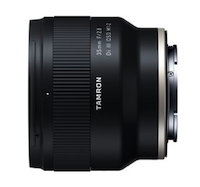 With its 35mm fixed focal length, this lens is perfect for everyday situations, from portrait photography to landscape shots.
With its 35mm fixed focal length, this lens is perfect for everyday situations, from portrait photography to landscape shots.
What’s more, the lens is a lightweight at only about 200 grams and fits in just about any photographer’s camera bag.
Sony 35 mm, f/2.8
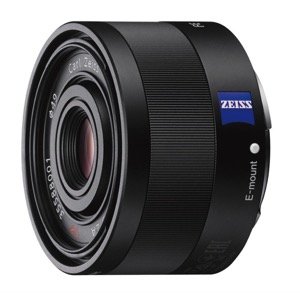 The somewhat lighter wide-angle lens from Zeiss is very well suited for landscape and street photography.
The somewhat lighter wide-angle lens from Zeiss is very well suited for landscape and street photography.
The lens is small and compact, making it the perfect match for the similarly compact Alpha 7 cameras.
The lens costs around 600 euros and won’t take up much space in your camera bag.
Sony Zeiss 35 mm, f/1.4
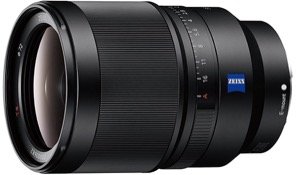 And yet another 35 mm prime lens from Sony. This lens excels with its incredible lens speed of f/1.4. However, that also means it’s very bulky and heavy.
And yet another 35 mm prime lens from Sony. This lens excels with its incredible lens speed of f/1.4. However, that also means it’s very bulky and heavy.
But the image quality is excellent and the bokeh is also very impressive. This lens is priced at around 1,000 euros.
Samyang 35 mm, f/2.8
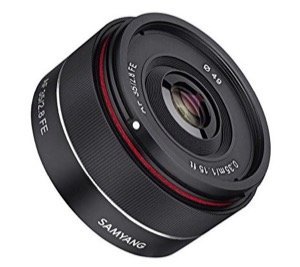 This lens from Samyang is a very good alternative to Sony’s own lenses in the 35 mm fixed focal length range.
This lens from Samyang is a very good alternative to Sony’s own lenses in the 35 mm fixed focal length range.
Especially the small size and the light weight make this lens so interesting. The image quality is good and the price is still reasonable at around 200 euros.
Samyang 35 mm, f/1.4
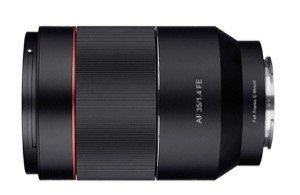 This lens by Samyang adds even more heat to the competition in the 35mm fixed focal length segment.
This lens by Samyang adds even more heat to the competition in the 35mm fixed focal length segment.
You can get this lens with an aperture of f/1.4 for less than 500 euros. The quality may not be on par wih the Sony lens, but it only costs a third of the price.
Sigma Art 35 mm, f/1.4
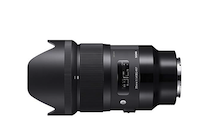 A very popular “always on” lens for many amateur and professional photographers. Not only is it wonderfully fast, but it’s also handy for a variety of purposes, from landscape photography to close-ups with great bokeh.
A very popular “always on” lens for many amateur and professional photographers. Not only is it wonderfully fast, but it’s also handy for a variety of purposes, from landscape photography to close-ups with great bokeh.
That makes it an amazing bargain at a price of less than 800 euros.
Sigma Art 35 mm, f/1.2
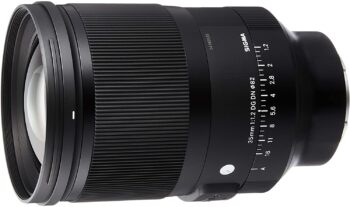 Sigma also offers a 35 mm lens. This lens was developed especially for mirrorless full-frame cameras and is reported to perform even better on the camera than the Sigma 35mm lens profiled above.
Sigma also offers a 35 mm lens. This lens was developed especially for mirrorless full-frame cameras and is reported to perform even better on the camera than the Sigma 35mm lens profiled above.
It’s also a bit faster with a lens speed of f/1.2 and the image quality is exceptional. And so is the price. The lens currently sells for about 1,350 euros.
Samyang 45 mm, f/1.8
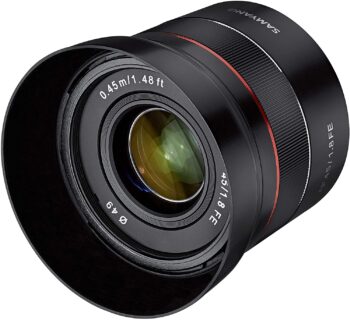 Samyang has quite a few lenses with autofocus in its range nowadays. All of them are of high quality, but still comparatively cheap compared to most Sony or Sigma lenses.
Samyang has quite a few lenses with autofocus in its range nowadays. All of them are of high quality, but still comparatively cheap compared to most Sony or Sigma lenses.
The 45 mm is special because the focal length is rather unusual. The normal focal length for full-frame lenses is typically around 50 mm. In purely mathematical terms, however, 45 mm is closer to the field of vision of the human eye, making this lens an interesting alternative.
This lens offers good value for money and stands out from the usual suspects.
Sony 50 mm, f/1.8
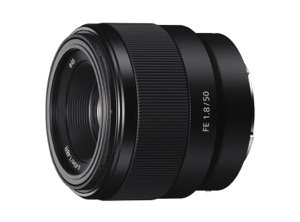 A very light and powerful lens at only 186 grams, easy to use for beginners. It takes very sharp pictures with an open aperture and can conjure up very pretty bokeh effects.
A very light and powerful lens at only 186 grams, easy to use for beginners. It takes very sharp pictures with an open aperture and can conjure up very pretty bokeh effects.
We were lucky enough to snatch up a bargain at a clearance sale, but even at full price, it’s a very affordable lens. The image quality is simply outstanding for the price, but unfortunately the autofocus is very loud and slow. If you can live with that, this lens is definitely a good investment at less than 200 euros.
Samyang 50 mm, f/1.4
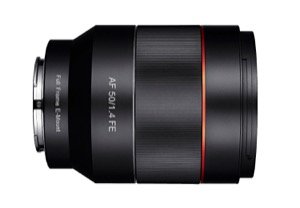 Samyang offers another inexpensive alternative with its 50 mm lens.
Samyang offers another inexpensive alternative with its 50 mm lens.
The image quality is very good and the lens is extremely fast with a maximum aperture of f/1.4. Only the autofocus leaves something to be desired with this lens.
But it still might be worth considering due to its low price of about 500 euros.
Sony 50 mm, f/1.4
 Sony also offers its own 50 mm, and it’s an absolute top-of-the-range lens. The lens stands out due to its great resolution, high lens speed, and super-smooth bokeh.
Sony also offers its own 50 mm, and it’s an absolute top-of-the-range lens. The lens stands out due to its great resolution, high lens speed, and super-smooth bokeh.
It’s quite bulky for a 50 mm lens, but the photo quality is excellent all around. The price isn’t exactly low at just under 1,400 euros. But then again, it’s certainly justified for a high-quality lens with Zeiss technology.
Sony 55 mm, f/1.8
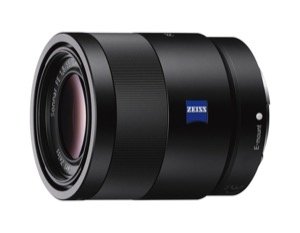 This lens offers superb image quality even in low light conditions, beautiful bokeh effects, and a fast autofocus.
This lens offers superb image quality even in low light conditions, beautiful bokeh effects, and a fast autofocus.
Sharpness, contrast, and the colors of the images turn out almost perfect, and at a price of about 750 euros this lens is almost a bargain.
Samyang 75 mm, f/1.8
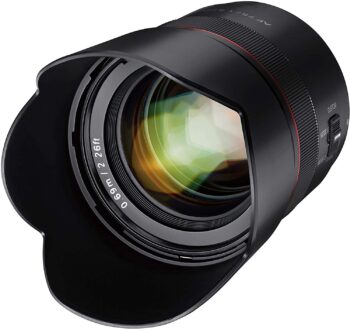 This lens from Samyang also has an unusual focal length with its 75 mm. 85 mm is more common for portrait lenses, but the 75 mm in combination with its aperture of f/1.8 is just as capable of producing a great background blur, so you can really make your subject stand out.
This lens from Samyang also has an unusual focal length with its 75 mm. 85 mm is more common for portrait lenses, but the 75 mm in combination with its aperture of f/1.8 is just as capable of producing a great background blur, so you can really make your subject stand out.
For about 360 euros you get a very compact lens that’s ideally suited for portrait photography.
Sony 85 mm, f/1.4, portrait lens
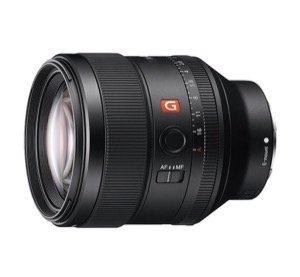 The 85mm lens for Sony E-mount is probably one of the best portrait lenses on the market today. With its 821 grams, the lens isn’t exactly a lightweight, but it delivers excellent images.
The 85mm lens for Sony E-mount is probably one of the best portrait lenses on the market today. With its 821 grams, the lens isn’t exactly a lightweight, but it delivers excellent images.
The autofocus is very precise, while the sharpness and the level of detail are simply outstanding. Every hair of your model will be visible on the picture, that’s how sharp this lens shoots.
Of course, all this comes at a price. You’ll have to put down about 1,500 euros for this premium lens.
Zeiss 85 mm, f/1.8 portrait lens
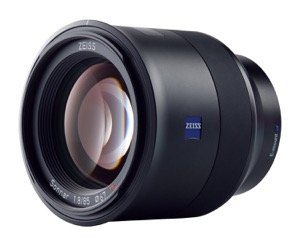 The 85 mm lens from Zeiss is considerably lighter and also much cheaper. It’s also a very good lens for portraits, has an optical image stabilizer, and of course it’s very fast.
The 85 mm lens from Zeiss is considerably lighter and also much cheaper. It’s also a very good lens for portraits, has an optical image stabilizer, and of course it’s very fast.
It’s also relatively light for its size and handles well. The sharpness of the aperture is great, and so is the bokeh. The Batis also has an OLED display, which shows depth of field and focus distance.
The lens exhibits typical Zeiss quality workmanship, although the plastic lens hood is a bit of a disappointment disappointing. But all in all, it’s a high quality lens that could be yours for about 1,000 euros.
Sony 85 mm, f/1.8
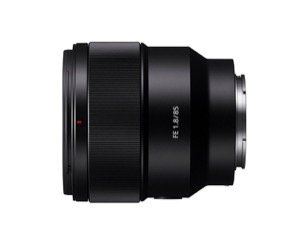 Aside from the premium lens, Sony also offers a second 85mm lens.
Aside from the premium lens, Sony also offers a second 85mm lens.
It has an aperture of f/1.8 and a surprisingly good image quality. At 500 euros, this portrait lens definitely offers the best value for money in the market.
Sigma Art 85 mm, f/1.4
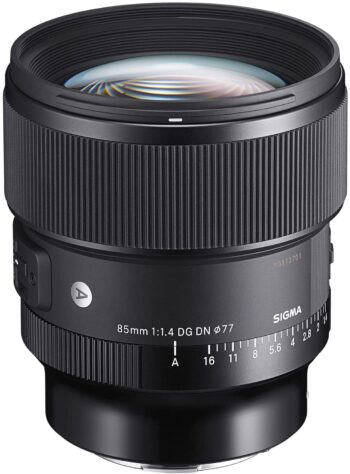 As with the other lenses, this Sigma is a slightly cheaper alternative to its Sony counterpart.
As with the other lenses, this Sigma is a slightly cheaper alternative to its Sony counterpart.
Once again, Sigma also places a premium on quality with this lens, so you can buy this lens without second thought and still expect performance on par with Sony’s G Master lens.
And you can save a lot of money, because this lens costs about 1,000 euros – a good 600 euros less than the Sony.
Sony 100 mm, f/2.8
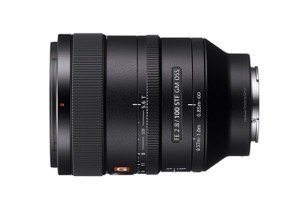 At first glance, this 100 mm lens from Sony’s G Master series with an aperture of f/2.8 wouldn’t seem to offer anything that would justify a price of 1,400 euros.
At first glance, this 100 mm lens from Sony’s G Master series with an aperture of f/2.8 wouldn’t seem to offer anything that would justify a price of 1,400 euros.
But take another look and you’ll be blown away because the lens excels with outstanding sharpness and an exceptional bokeh.
Sigma Art 105 mm, f/1.4
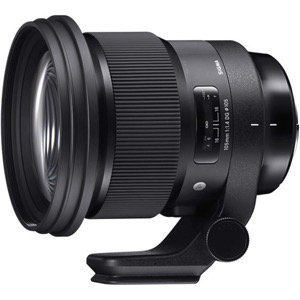 The second Sigma Art lens is a top-notch portrait lens. With a focal length of 105 mm and an aperture of f/1.4 it allows for wonderful bokeh and leaves nothing to be desired.
The second Sigma Art lens is a top-notch portrait lens. With a focal length of 105 mm and an aperture of f/1.4 it allows for wonderful bokeh and leaves nothing to be desired.
The price of around 1,400 euros may put some people off. But once you hold the lens in your hand, you’ll appreciate why it’s so expensive!
Zeiss 135 mm, f/2.8 telephoto portrait lens
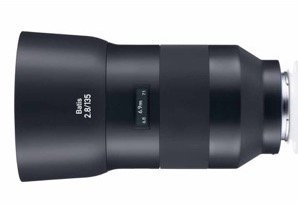 The 135 mm Zeiss Batis is a portrait lens with a fixed focal length of 135 mm. As usual for Zeiss, it meets the highest standards.
The 135 mm Zeiss Batis is a portrait lens with a fixed focal length of 135 mm. As usual for Zeiss, it meets the highest standards.
But then at a price of 1,400 euros, it isn’t just playing in the big leagues in terms of quality.
Sony 135 mm, f/1.8
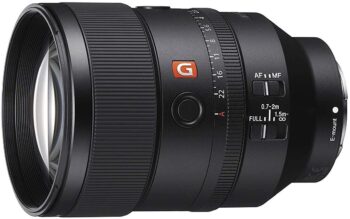 We’d say that the Sony 135 mm is the better alternative to the Zeiss 135 mm. The main difference is the higher lens speed of f/1.8, which makes it much easier to create a bokeh effect.
We’d say that the Sony 135 mm is the better alternative to the Zeiss 135 mm. The main difference is the higher lens speed of f/1.8, which makes it much easier to create a bokeh effect.
The autofocus is also reportedly faster than the Zeiss, making it so much more convenient for portraits in low light or with moving subjects.
The lens is a bit more expensive than the Zeiss lens at about 1,600 euros. However, it’s definitely worth the higher price.
Prime lenses for the Sony Alpha 7 series WITHOUT autofocus
And then there is a huge selection of prime lenses without autofocus for the Alpha 7 series. Manual focusing works very well with the Alpha 7 cameras’ focus-peaking function, so these lenses are certainly an alternative.
Since the selection is simply too large, we’ve made a list of all the available lenses. Once again, we’ve sorted them by focal length:
- Voigtländer Heliar 10 mm, f/5.6 HyperWide
- Samyang 12 mm f/2.8 Fisheye Lens – Amazon
- Laowa 12 mm f/2.8 – Amazon
- Samyang 14 mm T3.1 Cine Lens – Amazon
- Samyang 14 mm, f/2.8 – Amazon
- Voigtländer Heliar 15 mm f/4.5 SuperWide
- Laowa 15 mm f/4.0 Macro 1:1 Shift – Amazon
- Samyang 20 mm, f/1.8 – Amazon
- Tokina Firin 20 mm f/2.0 – Amazon
- Zeiss Loxia 21 mm f/2.8 – Amazon
- Samyang MF 24 mm f/1.4 – Amazon
- Samyang MF 24 mm, f/3.5 Tilt/Shift – Amazon
- Samyang 35 mm, f/1.4 – Amazon
- Zeiss Loxia 35 mm f/2.0 – Amazon
- Zeiss Loxia 50 mm f/2.0 – Amazon
- Zhongyi Mitakon 50 mm f/0.95 – Amazon
- Samyang 50 mm f/1.4 – Amazon
- Lensbaby Edge 50 mm f/3.2 – Amazon
- Lensbaby Velvet 56 mm f/1.6 – Amazon
- Lensbaby Twist 60 mm f/2.5 – Amazon
- Laowa 60 mm f/2.8 Ultra-Macro 2:1 – Amazon
- Zhongyi Mitakon 85 mm f/1.2 – Amazon
- Samyang 85 mm, f/1.4 AS IF UMC – Amazon
- Zeiss Loxia 85mm f/2.4 – Amazon
- Samyang 100mm f/2.8 Macro – Amazon
- Laowa 105 mm f/2.0 STF – Amazon
- Samyang MF 135 mm, f/2.0 ED UMC – Amazon
Please note: There are some other prime lenses with manual focus that aren’t available in Germany yet. We’ve only included lenses in our list that are available in Germany.
Which lens for the Sony Alpha 7 series would you recommend?
Wow, that was a lot of lenses! We hope our overview helped shed some light on the convoluted lens market.
Now we’re looking forward to hearing about your experiences. Which lenses do you use for your Alpha 7 camera? How satisfied are you with them? Which lens do we absolutely have to buy? Please let us know in the comments below.
Quick final note: We receive several emails every day with questions about which lens is best for a specific purpose. We hope you understand that we just can’t answer them all. As a small company, we simply don’t have the time. If you have any questions, please leave us a comment below the post and we’ll try to get back to you as soon as possible. Deal?
